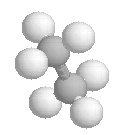1. I understand Carbon-12 has a relative atomic mass of 12 (and it contains 6 protons, 6 neutrons and 6 electrons) and that the mass of a proton plus an electron is less than the mass of a neutron. If so, then Carbon-12 divided by 12 has more mass than 1 proton plus 1 electron. Why then is the relative atomic mass of hydrogen greater than 12/12 or 1?
The reason for this effect is nuclear binding energy. A multi-proton atom's nucleus would fall apart (all the positive protons would repel) were there not some force holding it together. This is the nuclear binding energy. This energy is provided by a decrease in mass equal to E=mc2. Therefore the mass of Carbon 12 is less than the sum of the rest masses of 6 protons, 6 neutrons and 6 electrons.
2. What are polyatomic ions?
Poly means many, so a polyatomic ion contains "many" atoms.
Examples are:
- hydroxide OH-, (well, OK, "many" is a stretch at two atoms)
- carbonate CO32-
- ammonium NH4+
and so on
Some older texts will call these radicals. However, the term radical has a much different meaning in modern chemistry (a free radical is an atom (or molecule) that contains an unpaired electron), so it is better to call these groups of atoms that have a charge polyatomic ions.
When you are writing formulas for ionic compunds, you must always treat the polyatomic ions as a group. If more than one of these ions is required to balance the charges, then it is always placed in parentheses. For example:
| Calcium carbonate Ca2+ + CO32- Since there is only one of each ion, no parentheses are required |
Aluminum carbonate 2 Al3+ + 3 CO32- Since there is more than one polyatomic ion, parentheses are required. You don't use the parentheses for the monoatomic ion though. |
3. What are bonds?
Bonds are the "glue" that holds atoms together into groups that we call
molecules. Actually, all chemical bonds are caused by the simultaneous attraction of two
(or more) atom's positive nuclei, to the atoms' negative electrons. Therefore, all
chemical bonds are formed because of electrostatic attraction.
Chemical bonds will form when there is a lowering of potential energy because of this
electrostatic attraction. Without going into the details of quantum mechanics, it is not
easy to show this. However, at a simple level you can say that if there are more
attractions (between + and - charges) than there are repulsions (between + and + or - and
-) then the bond will cause a lowering of potential energy and so will form. So, two H
atoms can join to form H2, while two He atoms cannot.
4. How do they measure the number of protons and consequently the
atomic number of a element?
The number of protons was first determined by Moseley. He examined the
X-Ray spectra given off by a large number of metal atoms. In the spectra he
discovered that there was a pattern that repeated itself in a regular way, each differing
by an interger multiple of the previous atom. The conclusion he reached was that
there was something in the nucleus of the atom that increased by one as you went from one
atom to the next in the periodic table. Since the masses did not increase
by one, he called the property that was changing by one the atomic number.
Now if you start with H, and assume that it has one proton in its nucleus, then Moseley's
atomic numbers are all multiples of the H atom's nucleus. So atomic number = number of
protons.
5. How do I calculate the molar mass of CO2 (or CH4, or Ca(OH)2) or any other of a million possible formulas?
Read through the material about molar mass. The answer to this specific question is at Calculating formula masses.
6. What is the mass of 0.25 mol of CO2 (or any other formula)?
| a) Calculate the molar mass of CO2 (or the formula needed for the problem) | 44.0 g/mol (if you aren't sure how to calculate this, see Calculating formula masses) | ||
| b) Multiply the given number of moles times the molar mass | |||
| Make sure you include, and cancel the units. If you set up your problems this way, the units will cancel leaving you with the unit you want (mass is in g). | |||
7. What is the difference between an empirical formula and a molecular formula?
Emipirical means "by experiment". An empirical formula therefore is one that is determined by using experimental data (usually the masses of each element in a particular compound). These formulas are always expressed in terms of the lowest whole number ratio of each kind of atom.
| A molecular formula is the actual number of atoms in the compound's formula. For example, C2H6 (ethane) is a molecular formula, but the empirical formula for ethane is CH3. Click here for the solution to a typical empirical/molecular formula problem. |  Ethane |